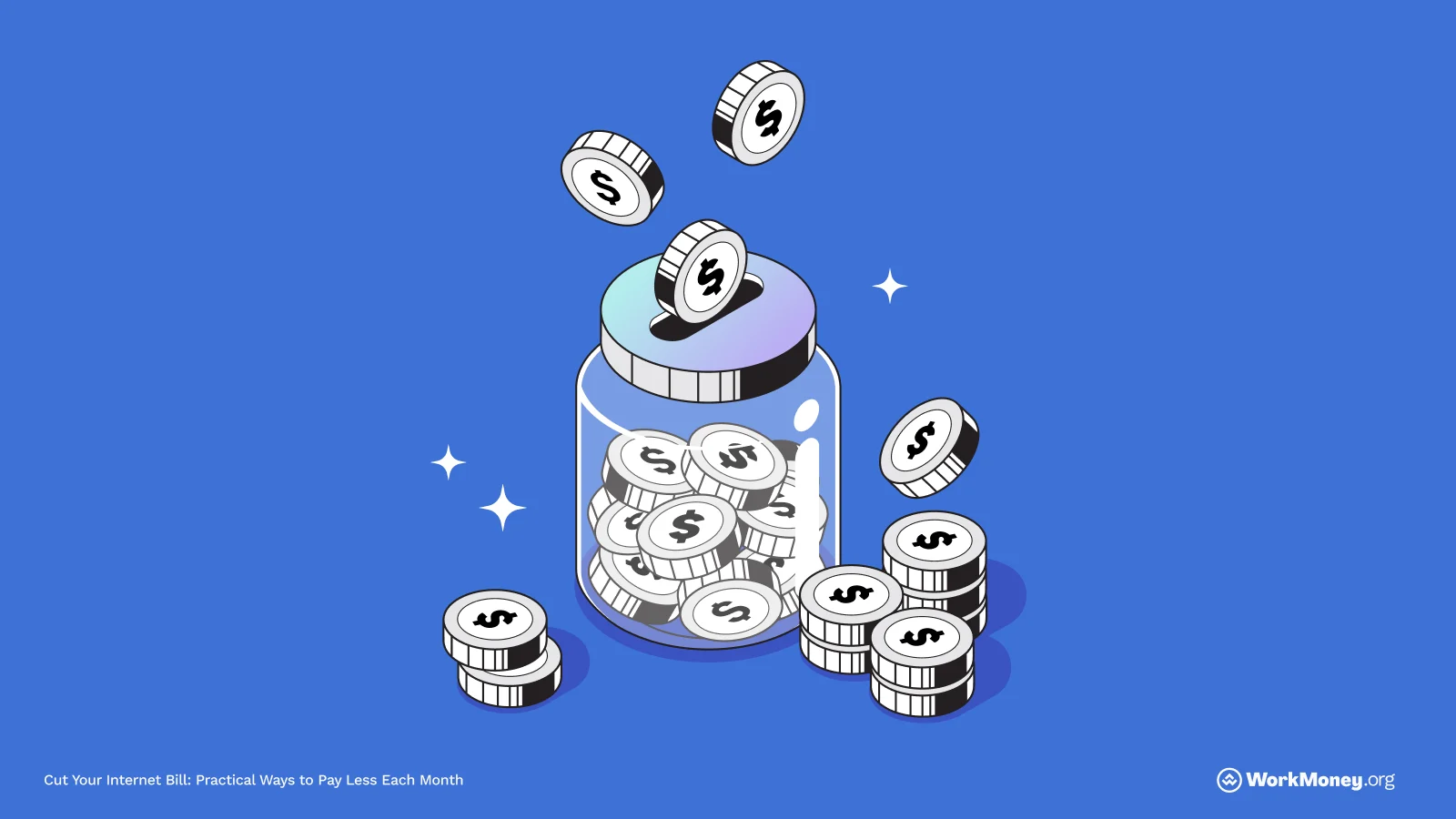10 Ways to Save Money Every Month
These smart, simple tips can help you save money each month - without giving up the things you love.

Saving money is often easier said than done, but with the right system in place, you can become the saver you’ve always dreamed of. Right now, with inflation driving up the cost of everything from eggs to electricity, it’s no wonder that saving is at the top of many Americans’ minds. Despite rising costs, the WorkMoney team is focused on helping you save and keep more money in your pocket.
Here are fast, easy ways to give your budget a little more breathing room without sacrificing what matters most.

1. Set Up Automatic Savings (Time: 5 minutes)
Out of sight, out of mind—that’s the magic of automation. The easiest way to do this is by setting up your paycheck to automatically split between different accounts. Keeping your savings in a separate account, for example, will make you less tempted to dip into it.
A popular budgeting tip to consider is the 50/30/20 rule:
50% of your income for needs (like rent, groceries)
30% for wants
20% for savings
But don’t stress about being exact—just give every dollar a job even if you’re only able to set a small percentage aside for savings.
Just starting out? Use apps like Acorns, Chime, or Qapital that automatically round up your purchases and save the spare change for you.
2. Open a High-Yield Savings Account (HYSA) (Time: 15 minutes)
The national average savings rate is just 0.6%. Some high-yield savings accounts (HYSAs) offer over 4%. That’s free money for doing nothing.
To put it into perspective, let’s say you keep $1,000 in savings:
At 0.6% APY, you’d earn $6 in a year
At 4% APY, you’d earn $40
It might not be life-changing money, but it’s much more than you’d make in a regular savings account. Plus, the more money you save, the more interest you earn. It’s a good incentive to save more.
A few popular no-fee high-yield savings account options include:
Ally Bank
SoFi
Marcus by Goldman Sachs
Capital One 360
3. Get Federal Assistance on Groceries
There’s no shame in using programs designed to help you through tough times—that’s what they’re there for. It’s not a handout, it’s a smart financial move by using the resources available to you.
SNAP (Supplemental Nutrition Assistance Program) provides monthly funds for groceries based on need, household income and size. Here’s what you can potentially qualify for:
# of people in household | USDA suggested grocery budget | SNAP monthly maximum benefit |
|---|---|---|
1 | $250-$400 | $292 |
2 | $500-$800 | $536 |
4 | $900-$1,500 | $768 |
There are a few ways you can apply. Here’s how long each step takes:
Online or paper application: ~30–60 minutes
Interview (if required): usually within 7–10 days
Processing: Up to 30 days (or 7 days for emergency SNAP)
This isn’t a long-term solution—but it can be a lifeline to help you get back on your feet.
Average savings: $292-$768 per month depending on household size
4. Save on Utility Bills with LIHEAP (Time: 20 minutes)
You aren’t alone if you’re falling behind on utility bills. Nearly one out of every seven households are behind on their electric and gas bills. If utility costs are crushing your budget, look into the Low Income Home Energy Assistance Program (LIHEAP). This federal program helps cover:
Heating and cooling bills
Past-due balances
Emergency repairs in some states
Eligibility depends on your income, household size, and location. Check your state’s program and apply.
Average savings: $250–$500 per year
5. Monitor Bills & Cancel Sneaky Subscriptions (Time: 10 minutes)
Free trials, forgotten apps, and monthly charges you don’t even use? The average consumer spends $273 per month on subscriptions without realizing it.
Apps like Rocket Money can help you:
Find and cancel unwanted subscriptions
Track recurring bills and monitor your spending
Get reminders for upcoming payments to avoid late fees
Taking a few minutes to use these tools can save you money and give you more control over your finances.
6. Get Instant Discounts with Access Perks (Time: 5 minutes)
Access Perks is an employee benefits program that offers discounts on a wide range of products and services. Through Access Perks, employees can save up to 50% on various categories like:
Groceries
Dining
Travel
Entertainment and more
Taking advantage of these discounts can lead to big savings.
7. Cut Back on Non-Essentials (Time: Flexible)
Completely cutting out “fun spending” isn’t sustainable. But smart swaps add up. A few tips to consider, include:
Rotate streaming services monthly to cut costs.
Do a pantry/freezer clear-out before buying more groceries.
Have a no-spend week once a month.
Skip beauty treatments (nails, hair) for a month.
Take public transit, carpool, walk or bike instead of driving to save on gas and parking.
Cook at home instead of takeout or delivery.
Buy second-hand for clothes, furniture, and electronics.
Cancel unused subscriptions (magazines, apps, software)
Apply a 24-hour rule before impulse purchases.
Pro tip: Set up a “fun fund” to use guilt-free. After all, you’re still allowed to enjoy life while saving.
8. Refinance or Consolidate High-Interest Debt (Time: Varies)
If you’ve borrowed money using a credit card or student loan, and the interest rate is high, it means you’ll end up paying a lot more than you borrowed. That’s because interest is like a fee added on top of your debt—and it adds up fast.
For example, if you owe $5,000 on a credit card with a 25% interest rate, you could pay more than $1,000 extra in just one year. The good news? There are ways to lower that cost.
Some options include:
A balance transfer to a credit card with 0% APR (no interest for a limited time)
A personal loan with a lower interest rate
If you have a good credit score, you’ll have a better chance at getting these deals. But even if you don’t qualify for the best offer, getting a lower rate can still save you money as it means more of your payment goes toward your actual debt—not just interest.
The same goes for private student loans. If you have high-interest loans, consider refinancing them. This can lower your monthly payment and save you money in the long run. Just make sure to shop around for the best rates and avoid taking on more debt while paying it off.
Average savings: Hundreds to thousands in interest per year
9. Take Advantage of Cash-Back and Rewards Programs (Time: 10 minutes)
Cash-back and rewards programs are an easy way to earn money back on purchases you’re already making. Here’s how to make the most of them:
Find the Right Card: Choose credit cards with no annual fee that offer cash-back or rewards in categories where you spend the most, like groceries, gas, or dining out. Some cards offer higher rewards, like 3% on groceries or 5% on rotating categories like gas.
Shop with Apps: Use apps like Rakuten or Honey for online shopping to get cash-back from your favorite stores. For in-store purchases, try Ibotta, which gives you cash-back when you scan your receipt or link your store card.
If you're already dealing with credit card debt, though, getting another card might not be the best choice as credit cards can tempt some people to spend more than they should.
The good news is, you don’t need a credit card to earn rewards! There are non-card programs that still give you similar perks for your everyday spending. Once you get the hang of it, this is an easy way to save or even make money.
10. Lower Your Insurance Premiums (Time: 15 minutes)
If you haven’t reviewed your insurance policies recently, you might be overpaying for coverage. Look for opportunities to:
Bundle auto and home insurance policies.
Compare rates from different providers annually.
Ask for discounts, such as safe driver or low-mileage discounts.
Final Thoughts
Saving money fast can feel impossible, but by taking a few proactive steps, you’ll be surprised how quickly the numbers shift in your favor. Even if you start with just one tip, you’re one step closer to a more stable, confident financial future.
About the Author

Brett Holzhauer
Brett Holzhauer is a Certified Personal Finance Counselor (CPFC) who has reported for outlets like CNBC Select, Forbes Advisor, LendingTree, UpgradedPoints, MoneyGeek and more throughout his career. He is an alum of the Walter Cronkite School of Journalism at Arizona State. When he is not reporting, Brett is likely watching college football or traveling.



